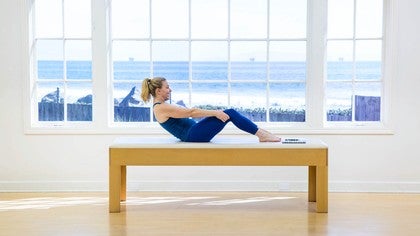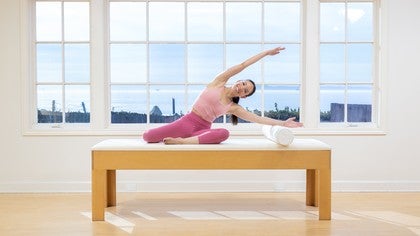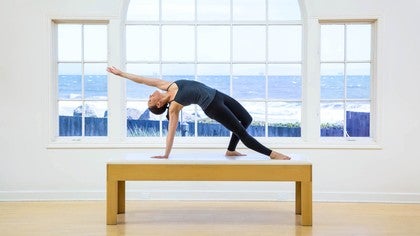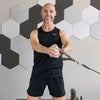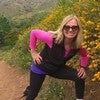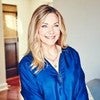Description
Please let us know in the comments if you have any questions. We want to help you be successful in your practice!
About This Video
Transcript
Read Full Transcript
Hi everyone. I'm here to take you through an assessment. We think it's important that you start off with this self assessment of your skill level and just some certain fundamental skills as you start your Polonius practice and your Polonius journey. We all start with a certain ability in our body. It's all good. But as you progress through your Palladio's lessons in your classes on piles, any time you'll be noticing how you start off versus how you are kind of maybe had been three or four months down the road and then maybe a year from now and then on and on and through the rest of your life, take these assessments, come back on often and check in on them and see how you're progressing. So we do like to have a starting off place and then a place to progress too.
It's a way to chart and to measure, uh, where you're going and how you're doing and how you're feeling in your body. So you might want to take something like a little daytime planner or day planner and really devote this and make this your polities journal if you will. And start out day one, my assessment of my standing roll down or you know, you'll see and be honest about what you feel and what you see. Uh, I would recommend, I think we'd recommend maybe every four weeks, come in and check on it and then every four weeks and check on it again. All right, so the goal is progress and progression, ease in your body and some of the fundamental uh, assessments we'll be doing. I'm going to pick out four for us.
We'll cover some flexibility where you're starting out with some spine and leg flexibility right away. Um, mobility of your spine on in your starting off point, a strength. You'll see a long stretch position. Sometimes you'll hear it called a plank long stretch position. And then also a posture assessment. Just very general. All right, so those four things we'll start with flexibility and how I want us to start and you can stand up with me. Um, with your feet close together, I'm going to do heels together, toes slightly away, pull your legs in pretty close and tight. Reach your arms up. This is part of some flexibility. Okay. But really what it will be more about is your leg and s and back flexibility.
That's what this assessment is for. All right, so I'm going to have you very slowly, everybody start to roll or round your body forward. Your arms can just be loose out in front of you. The key point is to keep your legs straight. That's what we're trying to assess is how low, how far over and how low you can get to the ground with your knees straight. Okay? That matters.
A great deal for this assessment and how you go through the lessons of plots. Okay, so if you only get down, maybe something like this with your hands in front of your knees, write that down in your journal. If you go in front of your shins, write it down. How does it feel? Also, I would recommend, how does it feel to get this low? If you're this person and you're all the way down, that's fine. Write down how you go and how it feels to be there. All right, so flexibility, test one. Now the another assessment similar, but if you're lying down you can check your leg flexibility a little bit more specifically. That was actually spine and leg general.
This will be more just leg. Okay, so I'll have you take one leg down low on the mat, take your other leg up. You can put your hands behind that thigh and remember we're trying to see how much we can straighten the knee. Okay, so if you take your knee and straighten it and you can still hold onto your leg. Wonderful. You might be this person down here struggling to get your knees straight. That is completely fine. Mark it down. Write it down.
This is just a general assessment of where your skill level is in this today. Maybe you're here again, maybe you're this person, write it down. How does it feel? Maybe you're this person. We, you know, you're the bendy type of person. It's all good. We want to chart our progress and see how we make changes. Okay? Yes. Next one. I'm going to come up to sitting for this one in Polonius, both on the equipment and on the mat. We talk a lot about flexibility's one of the primary, um, well, many primary things, but you'll build your flexibility for sure.
Every exercise in [inaudible] has something that's being stretched. Someplace in your body, something that's being stretched, something that's being strengthened all the time, as well as a deep sense of mobility and a lot of focus of posture. Okay? So that's why I've chosen those four to assess. So if we move on to assessment number two, this will work our spine. We're going to check in on our spine. So I'd like you to sit up like I am. Bend your knees, your feet are down, hands behind your knees and legs, and see what it feels like first and foremost, to sit up like this tall.
If this does not feel easy, write it down. All right? Hopefully it feels okay. But some of you, this might not feel easy. It'll feel easier as you do your pull audience practice. So here we go. First part to move, it's your pelvis and I want you to think of rolling your hips and your whole pelvis back away from your legs. You're going to roll kind of over your, your bottom and into your low back region until your arms are street.
Okay? It's okay if your feet are doing this toes up, that's fine. Ideally feed her down, but let's see how it feels in your spine to go back there like that. If that's easy, great. I'll show you the next. Now when you come back up, see if you can bend your elbows just a little bit and come back up fairly mobile, meaning you didn't have to kind of struggle and kick your legs to get yourself back up no matter what happened, write it down. I'm not writing it down, but you write yours down. Okay, and how did it feel? So the second one, let's say this first round was fairly simple for you. Great. I NVU by the way, check and see if you can hold your arms out there and still mobilize yourself back up relatively easily. Okay. Relatively easy.
And then let's see what happens. If you roll all the way back to backward, the end place will be to get your head on the mat. Okay? And see what happens. If you roll up, this is quite a bit about how mobile your spine is doing. This movement [inaudible] has a lot of that type of movement pattern in it and so we're really wanting to build a beautiful mobile, supple spine. Write that down. All right, and next layer to that assessment is with your legs straight and you may feel, I want you to kind of take a look at this shape of my um, movement right here. I'm reaching my arms to my legs, over my legs, but I want you to pull your stomach back.
This is a great way to feel your back stretch, but let's see if you can get mobile and how mobile you are going all the way back again to your head. Your arms will go back a little bit and all the way up, relatively easy.
See what that feels like to do. One more assessment, mobile mobility in your spine, suppleness in your back muscles and flexibility in your spine and your legs to the self. Assess yourself here. This shape comes up a lot in politeness, so let's see where you're at with that. So write that down. Okay. Your third one is going to be something that has more to do with where you are today with your initial strength in, I'm going to call this your center. So your stomach muscles, your you kind of, your button, your hips, and your back all in one kind of central area. Okay? So we call it, you'll hear it as a plank or a long stretch. So where you're at is it really does test your strength. I will tell you that your hands are underneath your shoulders, right?
Like that. You can have your hands open or closed at this to check in. You have one leg back with your toes bent down the second leg back. Okay? And then hold yourself there. You're in a nice long line. Your ribs are in, meaning you don't have your ribs spilled out. You're telling me how you want to feel as though you're a plank of wood.
Nice solid piece of wood. How long can you stay there? Okay, I'm going to say the alphabet one whole time. A, B, c, d, F, g, H, I, J, k, l, m, n, O, p, Q, r. S, t, u. V. W. X, Y, and z. If you made it through way to go write it down, you got through the alphabet one time, maybe the next time you assessed that you try to go through it twice. You see what I'm saying? And then three times, maybe four times, you can find another way to assess your strength in that position. Timing it on your watch, on your phone, something like that. Um, reciting your favorite poem. I don't know, but what we're trying to assess is how strong did you feel in that basic position, knowing this base, that position.
I'm going to give you some hints are all over the place and is on your side, on your front, up on your hands and legs, on the mat, on apparatus. So where is your strength today? All right. Lastly, let's talk about posture because PyLadies talks about posture a lot and it starts at the pelvis oftentimes, but this assessment will really be more about your upper back, your neck, and your shoulders. So let's see where you're at first and how you're going to chart that and write it down and then know where you can progress to. All right, so follow me over to the wall. I'm going to go right here by the window wall and way you can assess yourself.
Do yourself near a wall, anywhere, your house or a studio. What we're looking for is a goal pelvis. The back of your pelvis is against your wall. Your mid rib cage is against the wall. Your shoulders are not sloped forward this way, but they're rather back and hopefully the back of your head is against the wall, but not by lifting the Chin to get the head back, literally by just having the ease in your body to have your head go back.
Okay? If you are not there, write it down. It's okay that you're not there. Many people are not there when they start. Okay? I can tell you that I was not here when I started either. I was, oh, I'll mess. But over time I've gotten a lot more aligned in a lot more sound in my posture. A goal would be that this becomes easy. You get right there, you walk through the world and through your life with this type of posture, not because you're having to force it, but because you've done your Palladio's practice that's changed your posture to something more efficient and ideal. Okay? So again, we tested flexibility.
We checked our mobility of our spine two or three ways. We looked at a basic strength move that you see and we took, took a look at posture. Our recommendation again is chart it now, see how it feels and then maybe in about a month, reassess, improve upon and keep going forward. If you have any questions at all about what this was and why this matters, that's important to us, definitely write in and ask us about that. Okay. Again, we're here to help you have success and make this a pleasurable experience. And one that's very empowering. Um, and to expedite your progress. Because I want specifically, I want you to get from here to excellent and ease and strength quickly.
All right, so take a look. Let us know how it goes. Bye Bye.
Beginner Mat Workouts: 20-Minute Classes
Comments
You need to be a subscriber to post a comment.
Please Log In or Create an Account to start your free trial.
